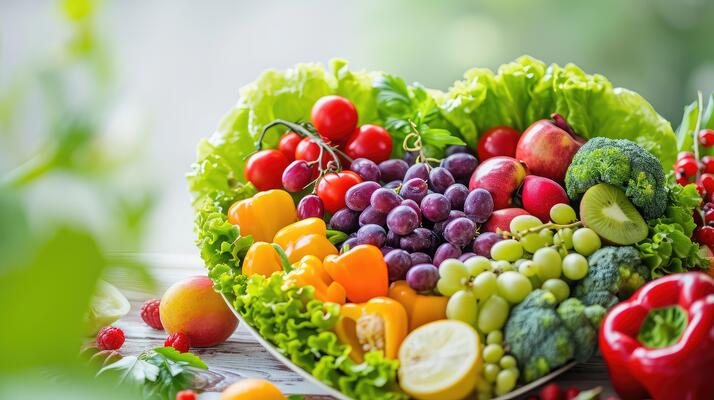Experiencing a heart attack is life-changing, and it’s essential to make some adjustments to your lifestyle to help your heart recover and stay healthy. One of the most important changes you can make is adjusting your diet. Eating the right foods and limiting certain others can help prevent future heart problems and support your overall health.
In this complete guide, we will explore the foods to eat and limit after a heart attack. This information is simple, easy to understand, and suitable for anyone looking to improve their heart health. Let’s get started!
Table of Contents
ToggleUnderstanding the Importance of Diet After a Heart Attack
A heart attack happens when blood flow to part of the heart is blocked, usually due to a buildup of fat, cholesterol, and other substances that form a blockage in the arteries. After a heart attack, it’s crucial to adopt a heart-healthy diet to reduce the risk of another one and improve your overall well-being.
Why diet is important:
- Helps reduce cholesterol levels
- Controls blood pressure
- Manages body weight
- Reduces inflammation in the arteries
- Supports the health of your heart and blood vessels
Making small changes to what you eat can have a significant impact on your heart health. Let’s dive into the foods you should include in your diet and those you should avoid.
Also Read: 10 Habits of Super Healthy People: Shine Bright from the Inside Out!
Foods to Eat After a Heart Attack
1. Fruits and Vegetables
Fruits and vegetables are essential for a heart-healthy diet because they are rich in vitamins, minerals, and antioxidants. These nutrients help protect your heart by reducing inflammation and preventing the buildup of plaque in the arteries.
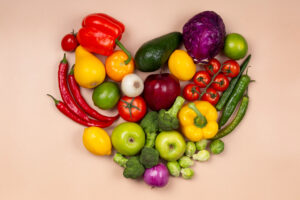
Why fruits and vegetables are good:
- High in fiber, which helps lower cholesterol
- Low in calories, making them great for weight management
- Packed with antioxidants that protect your heart cells
Examples of heart-healthy fruits and vegetables:
- Leafy greens like spinach, kale, and broccoli
- Berries like blueberries, strawberries, and raspberries
- Citrus fruits like oranges and grapefruits
- Carrots, tomatoes, and bell peppers
Aim to fill half of your plate with fruits and vegetables at every meal.
Learn more about the importance of fruits and vegetables for heart health.
2. Whole Grains
Whole grains are a key part of a heart-healthy diet because they contain fiber, which helps lower cholesterol and keeps your blood sugar levels stable. Unlike refined grains (like white bread), whole grains are not stripped of their nutrients, making them much better for your heart.
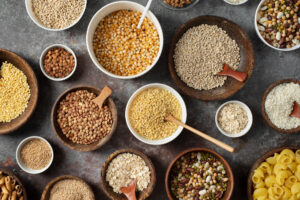
Why whole grains are good:
- Help reduce bad cholesterol (LDL) levels
- Improve digestion and keep you feeling full
- Lower the risk of heart disease
Examples of whole grains to include in your diet:
- Brown rice
- Whole wheat bread
- Oats
- Quinoa
- Barley
Replace refined grains with whole grains whenever possible to help support your heart.
Read more about the benefits of whole grains from the American Heart Association.
3. Lean Protein
Protein is essential for repairing your body’s tissues after a heart attack. However, not all protein sources are equal. It’s important to choose lean protein sources that are low in saturated fat, as high-fat proteins can raise cholesterol levels and increase the risk of heart disease.
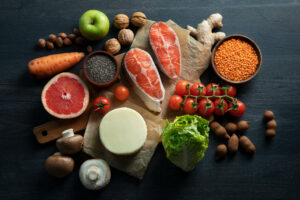
Why lean protein is good:
- Supports muscle repair and recovery
- Low in unhealthy fats
- Helps maintain a healthy weight
Examples of lean protein sources:
- Skinless chicken or turkey
- Fish, especially fatty fish like salmon, mackerel, and sardines (rich in omega-3 fatty acids)
- Plant-based proteins like beans, lentils, and tofu
- Eggs (preferably egg whites)
Omega-3 fatty acids, found in fatty fish, are particularly beneficial for heart health because they help reduce inflammation and lower the risk of arrhythmias (irregular heartbeats).
Find out more about lean protein from the NHS.
4. Healthy Fats
Not all fats are bad for your heart. In fact, certain types of fat, like unsaturated fats, are actually good for your heart and can help lower bad cholesterol levels.
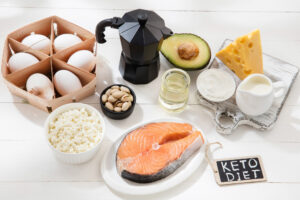
Why healthy fats are good:
- Help reduce bad cholesterol (LDL)
- Improve good cholesterol (HDL) levels
- Provide essential fatty acids for heart health
Examples of healthy fats:
- Olive oil
- Avocados
- Nuts and seeds (like almonds, walnuts, chia seeds, and flaxseeds)
- Fatty fish (like salmon and mackerel)
Use olive oil instead of butter or margarine for cooking, and snack on a handful of nuts instead of chips to incorporate more healthy fats into your diet.
Learn more about healthy fats from the British Heart Foundation.
5. Low-Fat Dairy
Dairy products can be a great source of calcium, which is important for bone health, but it’s essential to choose low-fat or fat-free versions to avoid the saturated fats found in full-fat dairy.
Why low-fat dairy is good:
- Provides calcium without the unhealthy fats
- Helps maintain healthy blood pressure
- Supports overall cardiovascular health
Examples of low-fat dairy products:
- Skimmed or semi-skimmed milk
- Low-fat yogurt
- Low-fat cheese
If you prefer plant-based options, choose calcium-fortified plant milks like almond or soy milk.
Discover more about dairy and heart health from Heart UK.
Foods to Limit After a Heart Attack
While there are plenty of foods that are good for your heart, there are also some that you should limit or avoid. These foods can increase your risk of heart disease and make it harder for your heart to recover after a heart attack.
Also Read: 10 Simple Steps to Increase Your Life Expectancy
1. Saturated and Trans Fats
Saturated fats and trans fats can raise your bad cholesterol (LDL) levels and increase your risk of developing heart disease. Saturated fats are found in animal products, while trans fats are often found in processed foods.

Why you should limit saturated and trans fats:
- Raise bad cholesterol levels
- Increase the risk of heart disease
- Contribute to the buildup of plaque in the arteries
Foods high in saturated and trans fats:
- Butter, margarine, and lard
- Fatty cuts of red meat
- Processed foods like pastries, cakes, and biscuits
- Fried foods like chips and fried chicken
- Full-fat dairy products like cream and cheese
Instead of using butter or lard for cooking, opt for olive oil or other plant-based oils, and try to limit your intake of processed foods as much as possible.
Learn more about reducing saturated and trans fats from the NHS.
2. Salt (Sodium)
Too much salt in your diet can raise your blood pressure, which puts extra strain on your heart. High blood pressure is a major risk factor for heart attacks and strokes, so it’s essential to keep your salt intake low.
Why you should limit salt:
- Increases blood pressure
- Increases the risk of heart disease and stroke
- Can lead to fluid retention, which is hard on the heart
Foods high in salt to avoid:
- Processed and pre-packaged foods like canned soups, ready meals, and instant noodles
- Salty snacks like crisps and pretzels
- Processed meats like bacon, sausages, and ham
- Sauces like soy sauce, ketchup, and salad dressings
To reduce your salt intake, try seasoning your food with herbs and spices instead of salt, and check food labels for hidden sources of sodium.
Read more about cutting down on salt from the British Heart Foundation.
3. Sugar
While sugar doesn’t directly affect your heart, consuming too much can lead to weight gain, high blood pressure, and diabetes—all of which are risk factors for heart disease. It’s important to limit your intake of added sugars, which are found in many processed and packaged foods.
Why you should limit sugar:
- Can lead to weight gain and obesity
- Increases the risk of developing type 2 diabetes
- Can raise blood pressure
Foods high in added sugars:
- Sugary drinks like soda, energy drinks, and fruit juices
- Sweets, cakes, and pastries
- Ice cream and sweetened yogurt
- Sugary cereals and granola bars
Instead of sugary snacks, opt for fresh fruit or unsweetened yogurt for a healthier alternative.
Find out more about cutting sugar from Heart UK.
4. Red Meat
Red meat, such as beef, lamb, and pork, contains high levels of saturated fat, which can raise your cholesterol levels and increase your risk of heart disease. While you don’t have to completely avoid red meat, it’s best to limit your intake and choose leaner cuts when possible.
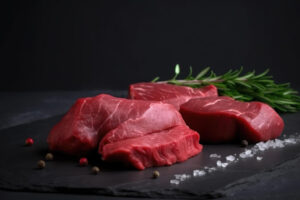
Why you should limit red meat:
- High in saturated fat, which raises bad cholesterol
- Increases the risk of heart disease
Alternatives to red meat:
- Lean poultry like chicken and turkey
- Plant-based protein sources like beans, lentils, and tofu
- Fish, especially fatty fish like salmon and tuna
If you do eat red meat, try to limit it to once or twice a week and choose lean cuts like sirloin or pork tenderloin.
Read more about the risks of red meat from the American Heart Association.
Heart-Healthy Tips for Meal Planning
Now that you know which foods to eat and limit, let’s talk about how to make heart-healthy meals that are delicious and satisfying. Here are some tips to help you plan your meals:
Also Read: Top 10 Anti-Ageing Foods To Add Into Your Diet! Eat Your Way to a Younger You!
1. Plan Balanced Meals
A heart-healthy meal should include a balance of fruits, vegetables, whole grains, lean protein, and healthy fats. Fill half your plate with vegetables, a quarter with lean protein, and the remaining quarter with whole grains. This ensures that you’re getting the right nutrients to support your heart.
2. Cook at Home
Cooking at home allows you to control the ingredients and make healthier choices. Use cooking methods like grilling, baking, steaming, or sautéing instead of frying. Avoid using too much salt or sugar, and opt for herbs, spices, and healthy fats like olive oil for flavor.
3. Read Food Labels
When shopping for packaged foods, always check the labels. Look for foods that are low in saturated fat, sodium, and added sugars. Choose products that are high in fiber and whole grains, and be mindful of portion sizes.
4. Stay Hydrated
Drinking enough water is essential for heart health. Water helps keep your body functioning properly and can prevent dehydration, which can strain your heart. Avoid sugary drinks and limit caffeine, as too much caffeine can raise your blood pressure.
Learn more about staying hydrated from the NHS.
Conclusion: Building a Heart-Healthy Diet After a Heart Attack
After a heart attack, eating the right foods can make a huge difference in your recovery and long-term heart health. Focus on incorporating plenty of fruits, vegetables, whole grains, lean proteins, and healthy fats into your meals while limiting unhealthy fats, salt, sugar, and red meat.
By making these simple changes to your diet, you’ll be taking important steps to protect your heart and improve your overall health. Remember to consult with your doctor or a registered dietitian for personalized advice on your heart-healthy diet.
For more information and support on heart-healthy eating, check out these resources:
- British Heart Foundation – Healthy Eating
- NHS – Eat Well
- American Heart Association – Healthy for Good
By following these guidelines, you can enjoy delicious, nutritious meals while supporting your heart’s recovery and health for years to come.
FAQ: Foods to Eat and Limit After a Heart Attack: A Complete Guide
1. What are the best foods to eat after a heart attack?
After a heart attack, it’s crucial to adopt a heart-healthy diet. The best foods to include are fruits and vegetables, whole grains, lean proteins, and healthy fats like those found in fish, nuts, seeds, and olive oil. These foods provide essential nutrients, fiber, and healthy fats that can help lower cholesterol, reduce inflammation, and support heart health. Aim to fill half your plate with fruits and vegetables, a quarter with lean proteins (like fish or plant-based options), and a quarter with whole grains such as brown rice or oats. Learn more about a heart-healthy diet from the British Heart Foundation.
2. Why is it important to eat whole grains after a heart attack?
Whole grains are a vital part of a heart-healthy diet because they are high in fiber, which helps to lower bad cholesterol (LDL) and regulate blood sugar levels. Unlike refined grains, whole grains retain their nutrients, including fiber, vitamins, and minerals. This can help reduce the risk of developing further cardiovascular issues. Examples of whole grains to include are brown rice, whole wheat bread, quinoa, and oats. Replacing refined grains like white bread or white rice with whole grains is a simple way to improve heart health.
3. What types of protein should I eat after a heart attack?
The best protein sources after a heart attack are lean proteins that are low in saturated fat. Opt for skinless poultry, fish, and plant-based proteins like beans, lentils, and tofu. Fish, particularly fatty fish like salmon, mackerel, and sardines, is highly recommended because it contains omega-3 fatty acids, which help reduce inflammation and lower the risk of irregular heartbeats. Eggs (especially egg whites) can also be a good protein source, but it’s essential to limit the intake of red and processed meats, which are higher in unhealthy fats. Explore more about protein for heart health from the NHS.
4. Should I limit fat in my diet after a heart attack?
You don’t need to eliminate fat from your diet, but it’s essential to choose the right types of fat. Healthy fats (unsaturated fats) found in foods like olive oil, avocados, nuts, and fatty fish are beneficial for heart health and can help lower bad cholesterol levels. Avoid saturated fats and trans fats, which are found in red meat, processed foods, and fried foods, as they can raise bad cholesterol (LDL) and increase the risk of heart disease. Use heart-healthy oils for cooking, such as olive oil, instead of butter or lard. Learn about the benefits of healthy fats from the British Heart Foundation.
5. Is it safe to eat dairy products after a heart attack?
Yes, it is safe to consume dairy products after a heart attack, but it’s important to choose low-fat or fat-free versions to avoid the high levels of saturated fat found in full-fat dairy products. Skimmed or semi-skimmed milk, low-fat yogurt, and low-fat cheese are good options. These provide essential nutrients like calcium without contributing to high cholesterol levels. If you prefer plant-based alternatives, opt for calcium-fortified options like almond or soy milk. Limiting full-fat dairy products can help keep your cholesterol in check. Discover more about dairy and heart health from Heart UK.
6. What foods should I avoid after a heart attack?
To protect your heart after a heart attack, it’s important to limit or avoid foods high in saturated fats, trans fats, salt (sodium), and added sugars. These include:
- Processed and fried foods (like crisps, fried chicken, and fast food)
- Red and processed meats (like bacon, sausages, and salami)
- Full-fat dairy products (like cream and butter)
- Sugary drinks and sweets (like sodas, cakes, and pastries)
- Salty snacks (like pretzels and salted nuts)
These foods can raise bad cholesterol (LDL), increase blood pressure, and contribute to further cardiovascular problems. Read more about what to avoid after a heart attack from the NHS.
7. Why is it important to reduce salt intake after a heart attack?
Reducing salt (sodium) intake is crucial because too much salt can raise blood pressure, which puts additional strain on your heart. High blood pressure is a significant risk factor for heart disease and strokes. After a heart attack, it’s important to aim for a low-sodium diet by avoiding processed foods, ready meals, and salty snacks. Instead, flavor your food with herbs, spices, and lemon juice. Always check food labels for hidden sodium content and try to keep your daily intake below 2,300 mg, as recommended by most health guidelines. Learn more about reducing salt from the British Heart Foundation.
8. Can I still eat red meat after a heart attack?
While you don’t have to completely eliminate red meat from your diet, it’s essential to limit it after a heart attack because it is high in saturated fat, which can raise bad cholesterol (LDL) levels and increase the risk of further heart problems. Instead, focus on leaner cuts of meat or substitute red meat with poultry, fish, or plant-based proteins. If you do eat red meat, try to limit it to once or twice a week and choose lean cuts like sirloin or pork tenderloin. Avoid processed meats like bacon or sausages. Learn more about the effects of red meat from the American Heart Association.
9. How can I make healthier meals after a heart attack?
Making heart-healthy meals can be simple with a few key adjustments. Plan balanced meals that include a variety of fruits, vegetables, whole grains, lean proteins, and healthy fats. Cooking at home gives you control over the ingredients, so try using olive oil instead of butter, grill or bake instead of frying, and use herbs and spices to add flavor instead of salt. Reading food labels to avoid hidden sugars, salt, and unhealthy fats is essential. Meal prepping in advance can help you stick to your heart-healthy diet. Explore more heart-healthy cooking tips from the NHS.
10. Can I eat sugar after a heart attack?
It’s best to limit your intake of added sugars after a heart attack. While natural sugars found in fruits are fine, consuming too much added sugar (found in processed foods, sugary drinks, and sweets) can lead to weight gain, high blood pressure, and diabetes, all of which increase the risk of heart disease. Instead of sugary snacks, choose fresh fruits, unsweetened yogurt, or nuts as healthier alternatives. Opt for drinks like water, herbal tea, or unsweetened beverages instead of sodas or energy drinks. Keeping sugar consumption low is a key part of maintaining a heart-healthy diet. Learn more about cutting sugar from Heart UK.
